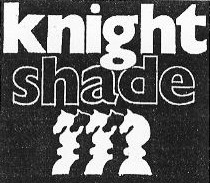Difference between revisions of "Knightshade"
Thedugganaut (Talk | contribs) m |
Thedugganaut (Talk | contribs) m (→Releases) |
||
| Line 15: | Line 15: | ||
<br> | <br> | ||
*''Blood and Money'' and ''Free Love'' appear on the 1986 [[Attack from Downunda]] compilation<br> | *''Blood and Money'' and ''Free Love'' appear on the 1986 [[Attack from Downunda]] compilation<br> | ||
| − | *''Television Eyes'' appears on the 1995 compilation [[Bark Number One]]<br>[[Category:bands]] | + | *''Television Eyes'' appears on the 1995 compilation [[Bark Number One]]<br> |
| + | *''Television Eyes'' appears on the 1995 compilation [[Kiwi Hit Disc 31]]<br> | ||
| + | |||
| + | [[Category:bands]] | ||
Revision as of 00:00, 30 September 2007
Knightshade were a successful mainstream/hair metal rock group in the late 1980s and 1990s. They had early chart sucess with Out for the Count in 1986 (five weeks in the chart, peaking at 26) and The Physical You in 1987 (seven weeks, peaking at 14). They also hit the album charts with their debut release Out For the Night in 1987 (three weeks in the album charts, peaking at 37). On the back of this sucess, they supported international acts ZZ Top and Stryper. All later releases were on Hark Records, including the 1995 single Television Eyes that had a video made by Greg Page.
The band included Wayne Elliot (lead vocals), Rik Bernards (guitar), gavin Lind (guitar), Jon Bell (bass) and Alan Grady (drums). Bernards and Bell had previously played together in The Bronx. Guitarist Rik Bernards taught music at WINTEC in the late 1990s, while Alan Grady has been the drummer for the Tim Armstrong band since 1997.
Releases
- 3 Points of Metal album, 1984 (with Tokyo and Strikemaster)
- Out for the Count single, 1986
- The Physical You single, 1986
- Out For the Night album 1987
- You Dont Need Me single, 1988
- Last Night in the City single, 1988
- Television Eyes single, 1995
- Knightshade best-of album, 1995
- Blood and Money and Free Love appear on the 1986 Attack from Downunda compilation
- Television Eyes appears on the 1995 compilation Bark Number One
- Television Eyes appears on the 1995 compilation Kiwi Hit Disc 31
